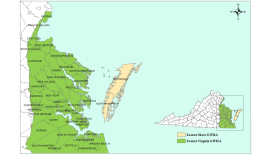Earlier this summer, we started hearing reports of dolphins in the Chesapeake Bay. Some thought it was unusual, others said it was no big deal. So Joel McCord went searching for them for Chesapeake: A Journalism Collaborative.
Dr. Helen Bailey, who did her PhD work on bottle nose dolphins, says she heard reports of occasional sightings of the marine mammals when she came to work as an associate professor at the University of Maryland’s Center for Environmental Science in Solomons.
But then the underwater microphones the lab was experimenting with began picking up the tell-tale squeaks and clicks of dolphins foraging in the Chesapeake and its tributaries. Now, the scientists are finding out the dolphins are pretty regular visitors to the bay.
"We were discovering that we were actually detecting dolphins quite frequently during June, July and August," she said. "And so then put another hydrophone in the Potomac River and there we were detecting dolphins every day."
She says they’ve been detected throughout the bay and many of its tributaries. But what drew them into the Bay?
"We think that they’re following the prey into the bay," Bailey says. "And getting a better understanding of how that is working is really important to understanding the eco system."
She says that’s a good sign, that the water quality in the Bay is improving and that fish stocks—the drum, croaker and menhaden that dolphins feed on—are in good shape.
But Shannon Lyons, another marine biologist, isn’t so sure.
Lyons is Chesapeake Program director for Southwings, an environmental non-profit that uses volunteer pilots to monitor waterways from the air. She says large algal blooms on the surface, which can be spotted from the air, create dead zones at the bottom.
That squeezes the fish dolphins feed on "into a narrow passage" and makes it "really easy for the dolphins to forage," she explained. "Kind of just like going down this lane with their mouths open, basically and finding the fish way more easily."
But she and the other scientists don’t know for sure and they want to know more. So, researchers at the Center for Environmental Science have created a "citizen scientist" app to track dolphin movements. It has a map to show reported sightings and allows you to report your own sightings. At last count, the app had more than 1.000 users who reported more than 700 dolphin sightings.
Dana Scanlon, one of those users, says she saw dolphins a couple weeks ago while sailing out of Annapolis with friends. They saw a little splash, and then one of her friends said, "Oh, look a dolphin," she recounted.
"And we kind of said whaaat? And all of a sudden we found ourselves sailing in a pod of just dozens and dozens of dolphins."
She says she says she’d never seen a single dolphin, let alone a pod, in years of sailing on the Bay.
"So, it was really extraordinary and we just spent the better part of an hour tacking and trying to stay close and circling around to stay within range of them," she said.
But, she added, they haven’t seen any since.
Lyons says things haven’t gone all that well for her SouthWings pilots, either. It’s really tricky, she explains, because they’re flying in tightly restricted airspace near federal installations on the Patuxent and Potomac rivers.
"So, we’re trying to figure out where it would be most advantageous to fly, and using the citizen scientists’ reports we can try to look and see where we should go for these surveys."
Captain John Marah has been running tourist cruises out of St. Michael’s aboard The Patriot for the last eight years, pointing out historic sites along the Miles River. He says he’s seen dolphins at least six of those years, but there has been nothing like this year.
"About two weeks ago we had a pod of easily 50. It was stunning, it was stunning," he recalled. "I first saw them off the dock of our house back there and then I came out in the Patriot and they were all the way down by the marker by the Oak Creek Bridge."
Now, he spots a dolphin or two every day or two. And when he does, he puts his engines in neutral and lets the fish swim around the boat, giving the tourists an extra show. The whole concept of a narrated historical cruise "just goes out the window," he says. "And we become a wildlife adventure cruise ‘cause I just can’t leave them. They’re mesmerizing. They’re just wonderful."
But Tommy Lewis, a pound netter on the Little Wicomico River on Virginia’s Northern Neck, is one of those who wonders what the big deal is.
"We see ‘em certain times of year, in the spring, see ‘em again in the fall, but nothing unusual and nothing great," he says. He used to see them when he was a kid.
"They come certain times a year, they feed, they migrate, they go back out the bay." Come September, they’ll be gone.
SouthWings’ Lyons says Lewis could be right. They’ve been here all along. It’s just that more people are hearing about it because of mushrooming social media.
Chesapeake: A Journalism Collaborative is funded with grant support from the Clayton Baker Trust, The Bancroft Foundation, Michael and Ann Hankin, The Jim and Patty Rouse Foundation, The Rob and Elizabeth Tyler Foundation, and the Mid-Shore Community Foundation.






